eden project |
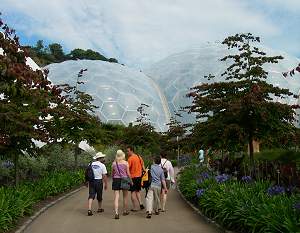 |
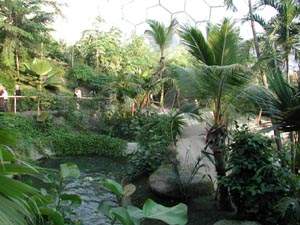 |
 |
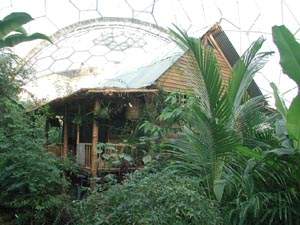 |
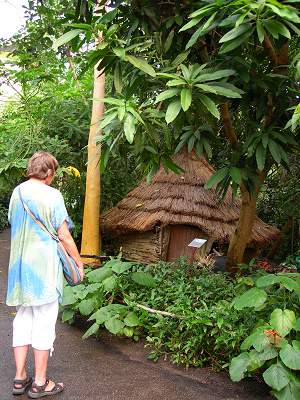 |
The Eden Project Humid Tropics Biome
The Humid Tropics Biome has been created in the World's largest conservatory (240m long, 55m high and 110m wide). The biome houses over 2000 species of carefully selected tropical plants in an environment that allows them to reach their full potential.
The soil in the biome is 1m deep and covers an area of 15590 square metres. The air is kept at temperatures varying between 35°C and 18°C - providing a variety of environmental niches in different areas of the biome. A misting system and a gigantic waterfall, provide the high humidity that the species in the biome require.
The Humid Tropics Biome is a place where you can explore environments that would be found in the Oceanic Islands, West Africa, Tropical South America and South East Asia. The biome allows you to experience the sights and smells from these distant parts of the World and see how the people of those regions, manage their environments - providing for their current needs and conserving the landscape for the future.
As you enter the biome, the sudden rises in both humidity and temperature have an instant affect. Spectacles and camera lens steam up and you notice a number of jackets being taken off quickly.
The Oceanic Islands
The first region that you encounter on your clockwise stroll through this impressive biome is the Oceanic Islands. The path takes you past the "Tropical Trader" - a sculpture of a ship's bows, created by local artist, David Kemp (constructed by the ship repairers at Penzance Dry Docks). Oceania has suffered badly by colonisation and introduction of new - and often inappropriate - species.
On display in this section in the Eden Project are species such as the coconut, Coco-de-mer from the Seychelles - the World's largest seed and the St Helena Ebony; a species that was, for over a hundred years, thought to be extinct. The feature also has a Mangrove section, displaying the remarkable plants that have adapted to exist in the regions where the forest meets the sea.
Malaysia
As you follow the path, which gently curves around the mangrove and tranquil pools you enter the Malaysian rainforest display.
The Asian house, constructed from rattan and bamboo, instantly impresses you sitting in its own kitchen garden.
The house is based on actual smallholdings found in the Borneo village of Kampong Tampinau. The gardens of the region provide food, building materials, medicines and crops to sell at the local markets.
The species in the gardens have been selected by the local population over the centuries, as examples of the best that the surrounding jungle has to offer, creating a year round larder where they always can find something to eat. The gardens are used to grow guavas, mangoes, sweet potatoes and the horseradish tree, with its edible roots, leaves, beans and flowers.
West Africa
Following the path, you come to the West African section of the biome, where the agro forestry techniques, as practiced by the people of Ndoumdjom in Cameroon, can be seen. Agro forestry allows farmers to produce food crops, cash crops and improve the soil of their environment. Crops of maize, coffee and sorghum are planted under the canopy of trees. The farmers also plant a species of leguminous trees, which can be seen at the side of the path, as these protect the crops, prevent soil erosion, provide a crop themselves and fix nitrogen in the soil - improving fertility.
Tropical South America
The path curves back on itself and the slight incline that you have hardly noticed so far, suddenly gets significantly steeper. As you round the bend, there is a path off to your left that allows those who are finding the slope, humidity and temperature too much, to leave the biome easily. It's a jungle in here.
The path rises sharply past this point as you travel through the Tropical South American section. The display is based on the shifting jungle cultivation of the people of Guyana. The people of the region move their gardens each year, on a 14 year cycle, to enable them to produce crops in the very poor jungle soils.
The path divides, giving you the option to climb up to the top of the waterfall, or take the easier route to the base of the falls. Climbing to the top of the falls opens up a whole new experience to you.
As you stand next to the somewhat industrial discharge pipes for the water you are immediately cooled by the strong downdraft created by the falling water. From this vantage point, you can look across the treetops, along the full extent of the biome.
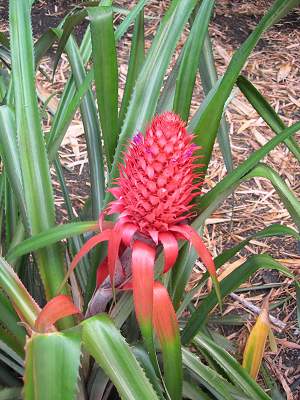 |
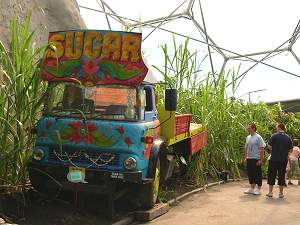 |
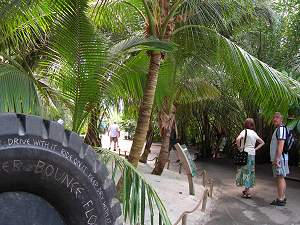 |
Walking through Eden's jungle displays, you quickly forget the fact that you are in a greenhouse; it is only the glimpses of the framework and the ETFE hexagons that spoil the illusion.
From the top of the falls, the true majesty and scope of this marvellous structure comes to the fore.
The views of the biomes as you walk down to the base of the clay pit area stunning, but the view from the top of the falls, across the treetops and pools, encompassed in a geodesic framework is something that everyone should experience.
From the top of the falls, the path begins its decent back to the base of the falls, meeting the original path, adjacent to a tranquil tropical pool.
At this point you are approximately half way along your jungle progression. The remaining sections of the biome are dedicated to the cultivated crops found in the tropics.
Crops and Cultivation.
The next section of our walk through the Humid Tropics Biome is marked a leopard sculpture. The rain forest provides our civilisation with many important materials. The second half of your walk through this biome features these economically important species; species that have had an important impact upon our lives. As you wander through this section, look out for special species such as the cola tree, which has become such a part of the global culture, Pineapples and peanuts.
You can easily miss the cola tree and chewing gum as you make your way along the path to the rubber section. From here you are led to the cocoa section, this species indigenous to the Andes, was originally used by the Mayan and Aztec peoples to make the "Drink of the Gods". These days most of the cocoa used to fuel our societies almost insatiable demand for chocolate is grown in West Africa smallholdings.
The whole latter part of this biome experience, takes you through the cultivated species that originated from the tropic. You get a chance to see Rubber Trees, Cocoa, Rice, Sugar cane, Bamboo, Palms, Coffee, Bananas growing and Spices.
The Humid Tropics Biome is a place where you will discover new things to see on each visit. It is a place where you need to ensure that you take your time, to enable you to get the best from the whole experience.
 LanhydrockFarm
Cottages - dating from the 1700's. Set in the beautiful and sheltered countryside
around Lanhydrock House (National Trust) - Treffry Cottages are 300 yds
from the Lanhydrock Estate. 15 minute drive to the Eden Project
LanhydrockFarm
Cottages - dating from the 1700's. Set in the beautiful and sheltered countryside
around Lanhydrock House (National Trust) - Treffry Cottages are 300 yds
from the Lanhydrock Estate. 15 minute drive to the Eden Project Two
luxury self catering log cabins - sleeping 2-8 people. Individually designed
& hand crafted with spacious character accommodation. One suitably equipped
for disabled persons. Ideally situated for exploring Cornwall
Two
luxury self catering log cabins - sleeping 2-8 people. Individually designed
& hand crafted with spacious character accommodation. One suitably equipped
for disabled persons. Ideally situated for exploring Cornwall Self
catering cottages and en-suite B&B. Historic property set in 10 acres with
superb views, outdoor swimming pool and indoor leisure facilities. Excellent
base for exploring Cornwall, Eden Project 6 miles.
Self
catering cottages and en-suite B&B. Historic property set in 10 acres with
superb views, outdoor swimming pool and indoor leisure facilities. Excellent
base for exploring Cornwall, Eden Project 6 miles.

